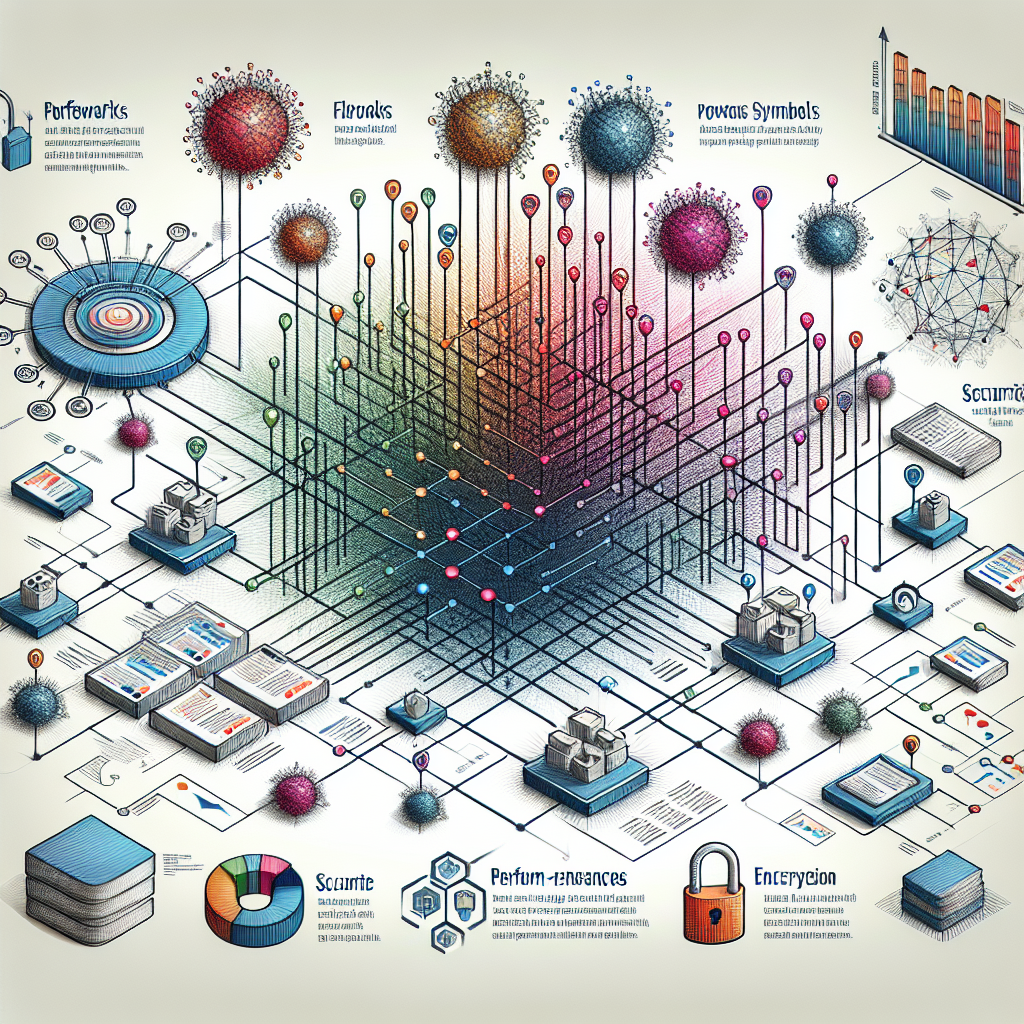In today’s interconnected world, network performance and security play a crucial role in ensuring seamless and protected communication. From data transfer speeds to safeguarding sensitive information, every aspect of network operations has far-reaching implications. Understanding the intricacies of network performance and security considerations is essential for businesses and individuals alike to avoid potential pitfalls and ensure smooth operations. This guide delves into the key factors that impact network performance and security, offering valuable insights and practical tips for optimizing both aspects. Join us as we navigate the dynamic landscape of network technology and explore the vital interplay between performance and security.
Understanding Network Performance
-
Factors Affecting Network Performance
Network performance is influenced by various factors that can impact the speed and efficiency of data transmission. These factors include: -
Bandwidth
Bandwidth refers to the maximum rate at which data can be transferred across a network path. It plays a crucial role in determining the speed at which data can be transmitted. Networks with higher bandwidth can support faster data transfer rates, resulting in improved performance. -
Latency
Latency is the delay that occurs when data is transferred between two points on a network. It is measured in milliseconds and can be influenced by factors such as the distance between devices, network congestion, and the processing speed of networking equipment. High latency can lead to delays in data transmission and impact network performance. -
Jitter
Jitter refers to the variability in latency experienced when transmitting data packets across a network. It can cause data packets to arrive out of order, leading to packet loss and decreased network performance. Minimizing jitter is important for maintaining a stable and reliable network connection. -
Importance of Network Performance in Internet Speed
Network performance is directly linked to internet speed, as it determines how quickly data can be transmitted between devices. A network with optimal performance characteristics, such as high bandwidth, low latency, and minimal jitter, will result in faster internet speeds for users. Understanding and optimizing network performance is essential for ensuring a seamless and efficient online experience.
Enhancing Network Performance
Utilizing Quality of Service (QoS) Techniques
- Quality of Service (QoS) techniques are essential for prioritizing network traffic based on specific criteria such as bandwidth, delay, jitter, and packet loss.
- By implementing QoS mechanisms, organizations can ensure that critical applications receive the necessary resources to function optimally, enhancing overall network performance.
- Differentiated Services Code Point (DSCP) markings can be utilized to classify and prioritize packets, allowing for more efficient data transmission across the network.
Traffic Prioritization
- Traffic prioritization involves assigning different levels of importance to various types of network traffic to ensure that essential data packets are delivered promptly.
- Prioritizing real-time applications like VoIP or video conferencing over less time-sensitive traffic can significantly improve overall network performance and user experience.
- Techniques such as packet scheduling algorithms and traffic shaping can be employed to prioritize critical traffic and prevent congestion in the network.
Bandwidth Management
- Bandwidth management is crucial for optimizing network performance by allocating available bandwidth efficiently to meet the demands of different applications and users.
- Implementing bandwidth allocation policies and traffic shaping mechanisms can help prevent bandwidth bottlenecks and ensure fair distribution of resources.
- Bandwidth monitoring tools can be used to analyze network traffic patterns and identify areas where bandwidth can be optimized to enhance overall performance.
Implementing Caching Mechanisms
- Caching mechanisms involve storing frequently accessed data or content closer to the end-users to reduce latency and improve network performance.
- By caching web content, applications, or DNS records, organizations can accelerate data retrieval processes and minimize the need for repeated requests to remote servers.
- Content Delivery Networks (CDNs) and caching servers can be deployed strategically to enhance the speed and efficiency of content delivery, especially for geographically dispersed users.
Upgrading Hardware and Infrastructure
- Upgrading hardware and infrastructure is essential for maintaining optimal network performance, especially as technology advances and network requirements evolve.
- Investing in high-speed networking equipment, routers, switches, and servers can help support increased data loads and improve overall network reliability.
- Upgrading to newer networking protocols, such as IPv6, can also enhance network performance and security by providing more efficient routing and addressing capabilities.
Monitoring and Analyzing Network Performance
Continuous monitoring of network performance is essential in maintaining the efficiency and security of a network infrastructure. By regularly monitoring and analyzing network performance, organizations can identify potential issues, troubleshoot problems, and optimize network resources to ensure smooth operations.
Importance of Continuous Monitoring
-
Proactive Issue Detection: Continuous monitoring allows for the early detection of performance issues such as bottlenecks, latency spikes, or bandwidth constraints before they escalate into major problems.
-
Resource Optimization: By monitoring network performance over time, organizations can identify patterns and trends that help in optimizing resource allocation and improving overall network efficiency.
Utilizing Network Monitoring Tools
-
Network Monitoring Software: Organizations can leverage specialized network monitoring tools that provide real-time data on network performance metrics such as bandwidth utilization, traffic patterns, and device health.
-
Alerting Mechanisms: These tools often come equipped with alerting mechanisms that notify network administrators of any deviations from normal performance thresholds, enabling prompt action to be taken.
Interpreting Performance Metrics
-
Throughput: Throughput refers to the rate at which data is successfully transmitted from one point to another within the network. It is a key performance metric that indicates the network’s capacity to handle data traffic effectively.
-
Packet Loss: Packet loss occurs when data packets fail to reach their intended destination within the network. Monitoring packet loss is crucial as it can impact the overall quality of service and user experience.
-
Round-Trip Time (RTT): RTT measures the time it takes for a data packet to travel from the source to the destination and back again. High RTT values can indicate network congestion or latency issues that need to be addressed promptly.
Network Security Fundamentals

Common network security threats
- Cybersecurity threats are diverse and constantly evolving, posing significant risks to network infrastructure and sensitive data.
- Common network security threats include malware, phishing attacks, and Distributed Denial of Service (DDoS) attacks that can compromise the integrity and confidentiality of information.
- Understanding these threats is crucial for implementing effective security measures to safeguard network operations and data assets.
Malware
- Malware, short for malicious software, encompasses a broad category of software programs designed to infiltrate and damage computer systems without the user’s consent.
- Types of malware include viruses, worms, Trojans, ransomware, and spyware, each with distinct characteristics and methods of exploitation.
- Preventive measures against malware often involve using antivirus software, regularly updating systems, and exercising caution when downloading files from untrusted sources.
Phishing attacks
- Phishing attacks are deceptive tactics used by cybercriminals to trick individuals into divulging sensitive information such as passwords, credit card details, or personal data.
- Common phishing methods include fraudulent emails, fake websites, and social engineering techniques that exploit human vulnerabilities rather than technical weaknesses.
- Educating users about recognizing phishing attempts and implementing email filtering mechanisms are essential strategies for mitigating the risks posed by phishing attacks.
DDoS attacks
- Distributed Denial of Service (DDoS) attacks aim to disrupt the availability of network services by overwhelming servers or network resources with a high volume of illegitimate traffic.
- Characterized by their distributed nature, DDoS attacks can be challenging to mitigate as they often involve multiple sources coordinating simultaneous attacks.
- Implementing DDoS mitigation strategies, such as network traffic monitoring, load balancing, and content delivery networks, can help organizations withstand and mitigate the impact of DDoS attacks.
Importance of data encryption
- Data encryption is a fundamental security measure that transforms plaintext data into ciphertext to protect it from unauthorized access or interception.
- Essential for ensuring data confidentiality, encryption technologies such as SSL/TLS protocols, VPNs, and disk encryption play a crucial role in safeguarding sensitive information both in transit and at rest.
- Compliance regulations and industry standards often mandate the use of encryption to protect customer data and intellectual property from breaches and unauthorized disclosures.
Role of firewalls and intrusion detection systems (IDS)
- Firewalls and Intrusion Detection Systems (IDS) are critical components of network security infrastructure that help monitor and control incoming and outgoing network traffic.
- Firewalls act as a barrier between internal network resources and external threats, filtering traffic based on predefined security rules and policies.
- IDS, on the other hand, analyze network traffic patterns and behavior to detect and alert administrators of potential security breaches or anomalies in real-time.
- Integrating firewalls and IDS into a layered security approach enhances network resilience and provides early detection and response capabilities against emerging threats and vulnerabilities.

Balancing Performance and Security
- Impact of security measures on network performance
When it comes to network performance, implementing robust security measures can sometimes have a noticeable impact. Security protocols such as encryption, firewalls, and intrusion detection systems can consume network resources and processing power, leading to potential slowdowns in data transmission and response times. The encryption and decryption processes, for example, can introduce latency, especially in high-traffic environments. It is crucial for organizations to carefully assess the trade-offs between security and performance to strike the right balance.
- Implementing security best practices without compromising speed
Achieving a balance between security and speed involves implementing security best practices that are efficient and effective. This includes optimizing configurations for firewalls and security devices to minimize unnecessary processing overhead. Employing hardware acceleration and offloading cryptographic operations to specialized devices can also help improve performance without sacrificing security. Network administrators should also prioritize network segmentation, access controls, and monitoring to enhance security posture while maintaining optimal performance levels.
- Importance of regular security updates and patches

Regular security updates and patches play a vital role in maintaining network performance and security. By promptly applying patches and updates released by software vendors, organizations can address known vulnerabilities and strengthen their defenses against emerging threats. Failure to keep systems up to date can leave networks exposed to potential exploits, leading to performance issues and security breaches. Continuous monitoring and proactive maintenance are essential components of a comprehensive security strategy to safeguard network assets while preserving overall performance.
Future Trends in Network Performance and Security
In the ever-evolving landscape of network technologies, staying abreast of future trends is crucial for organizations to ensure optimal performance and robust security measures. Here are some key considerations for future trends in network performance and security:
- Advancements in network technologies:
- The proliferation of 5G networks is set to revolutionize network performance by offering higher bandwidth and lower latency, enabling faster data transmission and improved user experiences.
- The adoption of Software-Defined Networking (SDN) and Network Function Virtualization (NFV) is expected to streamline network management and enhance flexibility in deploying security solutions.
-
The Internet of Things (IoT) will continue to expand, necessitating scalable network infrastructures to accommodate the growing number of connected devices and ensuring seamless connectivity.
-
Emerging security threats and challenges:
- With the increasing sophistication of cyber threats, such as ransomware attacks and data breaches, organizations need to implement robust security measures to protect their network assets and sensitive information.
- The rise of insider threats poses a significant challenge, highlighting the importance of access controls, user authentication mechanisms, and continuous monitoring to detect and prevent unauthorized access.
-
The integration of Artificial Intelligence (AI) and Machine Learning (ML) in security solutions is anticipated to enhance threat detection capabilities and automate response mechanisms to mitigate security risks effectively.
-
Importance of staying updated with industry trends:
- Continuous education and training on the latest network performance and security trends are essential for IT professionals to enhance their skills and knowledge, enabling them to proactively address potential vulnerabilities and mitigate risks.
- Collaboration with industry peers and participation in forums, conferences, and workshops can provide valuable insights into emerging technologies and best practices in network performance optimization and cybersecurity.
- Implementing a proactive approach to network performance and security, organizations can stay ahead of cyber threats and ensure the integrity and availability of their network infrastructure.
FAQs: Exploring Network Performance and Security Considerations
What are some factors that can affect network performance?
Several factors can impact network performance, including bandwidth limitations, network congestion, hardware limitations, and the number of users accessing the network simultaneously. Other factors such as network configuration, distance between devices, and the type of network protocols being used can also play a role in determining the overall performance of a network.
How can network security be ensured while maintaining optimal performance?
To ensure network security while maintaining optimal performance, organizations can implement a combination of security measures such as network segmentation, firewalls, intrusion detection systems, and encryption protocols. Regularly updating software and firmware, conducting security audits, and monitoring network traffic for any suspicious activity are also essential in maintaining a secure network without compromising performance.
What are some best practices for optimizing network performance and security?
Some best practices for optimizing network performance and security include regularly monitoring and analyzing network traffic, implementing quality of service (QoS) policies to prioritize critical data, limiting access to sensitive information through access controls, and conducting regular security training for employees to prevent security breaches. Additionally, using multi-factor authentication, implementing strong password policies, and regularly patching and updating software can help enhance network security and overall performance.


